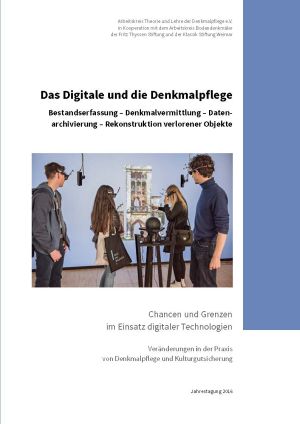
Zitationsvorschlag
Lizenz

Dieses Werk steht unter der Lizenz Creative Commons Namensnennung - Weitergabe unter gleichen Bedingungen 4.0 International.
Veröffentlicht
Das Digitale und die Denkmalpflege
Bestandserfassung – Denkmalvermittlung – Datenarchivierung – Rekonstruktion verlorener Objekte
Die „digitale Revolution“ ist längst in vollem Gange. Für die Denkmalpflege haben digitale Anwendungen neue Perspektiven geöffnet, etwa in der interaktiven Visualisierung verlorener Zustände, im Monitoring bedrohter Stätten und Artefakte oder in der komplexen Vernetzung heterogener Wissensbestände. Deutlicher werden inzwischen auch Grenzen und ungelöste Probleme im Einsatz digitaler Technologien, etwa was die Nachhaltigkeit der rapide wachsenden Datenmengen betrifft.
Doch haben wir es in Bezug auf die Digitalisierung nicht in erster Linie mit einer nur „technischen“ Neuerung zu tun. So wird das Bemühen um das digitale Erbe, mit dem Auftrag zur Dokumentation, Erforschung und Publizierung von Kulturgütern, nicht nur die Institution Museum transformieren. Zu beobachten ist auch, dass sich mit der neuen Fülle an digital erzeugten Bildern die wissenschaftlichen Standards verändern. Ein weiterer unterschätzter Aspekt der digitalen Revolution ist eine Umschichtung der Aufmerksamkeiten auf dem „Markt“ der Wissenschaften.
Die wohl auffälligste Folge des digitalen Versprechens einer genauen und verlustfreien Reproduktion des Verlorenen ist, dass bei jeder spektakulären Zerstörung von bekannten Monumenten reflexhaft die Forderung nach einer Rekonstruktion aufkommt. Deutlich wird hier, dass dem Digitalen eine innere Affinität zur Rekonstruktion innewohnt, insofern seine Leistungsfähigkeit in der Übersetzung aller Informationen in einen binären Code, in der angeblich verlustfreien Speicherung und Kopie beruht. Im digitalen Zeitalter wird die Unterscheidung von Original und Kopie so an Relevanz verlieren – auch zu dem Preis einer totalen Manipulierbarkeit der Daten, wie der Realität.






